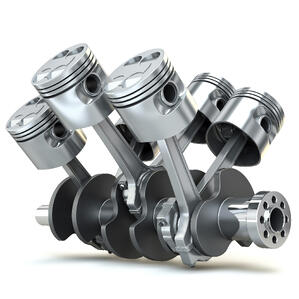
The advent of mechanical engineering, first in farming equipment and later in production factories, led to a dramatically increased pace of life. Many genius Inventors aimed to make the hard parts of life easier--such as finding a means of land-travel that would leave horse-drawn buggies in the dust.
One such brilliant mind, was the renowned painter and designer Leonardo da Vinci. In the early 1500's, he sketched a horse-less, mechanized buggy that was never realized. Still, the wheels had been set in motion.
In 1769, a Frenchman named Nicholas-Joseph Cugnot designed and built a "wheeled" vehicle that was self-propelled by a steam-powered engine. However, the invention moved at a walking pace and had to stop every twenty minutes to build a new head of steam. His heart was in the right place, but it was clear that steam wouldn't be powerful enough to reach the speeds that people were looking for.
 Thankfully, progress on the first internal combustion engine had already begun as early as 1680. By using explosive combustion of fuel to push a piston within a cylinder, these engines are still the core component of automobiles today. The first design was drawn by Christiaan Huygens, who envisioned the use of gunpowder as fuel. The vehicle was also never built, but left room for others to experiment with alternate forms of fuel.
Thankfully, progress on the first internal combustion engine had already begun as early as 1680. By using explosive combustion of fuel to push a piston within a cylinder, these engines are still the core component of automobiles today. The first design was drawn by Christiaan Huygens, who envisioned the use of gunpowder as fuel. The vehicle was also never built, but left room for others to experiment with alternate forms of fuel.
Many more inventive minds set to work on the concept. In 1858, Jean Joseph-Etienne Lenoir patented a combustion engine fueled by coal gas and operated by an electric, spark-ignition device. He even incorporated petroleum as the fuel, attached the invention to a three-wheeled wagon and traveled 50 miles. However, his miraculous vehicle was never adopted by the general public.
It is no surprise that the first marketable automobile was invented by a German, as their engineering prowess has been well-known for centuries. It was in 1886 that Karl Benz first patented the "Motorwagon", which utilized an internal combustion engine that used gasoline as fuel and worked largely the same as cars do today. Benz also patented his own throttle, spark plug, gear shifter, water radiator and carburetor, all of which were components of the three-wheeled vehicle. With 2.5 horsepower and a max speed of 25 MPH, The Motorwagon first hit the road with Benz's wife, Bertha, behind the wheel. She had become frustrated with her husband's lack of marketing skills, and decided to take matters into her own hands. Piling her two teenage sons into the back, she drove 65 miles in 12 hours to her parent's home and proved to the world that her husband's invention worked.

Of course, all of this happened before Americans tried their hand at the task of increasing humanity's speed capabilities. Stay tuned next week for the story of Henry Ford and his Model T, the automobile that built off of Karl Benz's design and became the most popular, user-friendly vehicle the world had ever seen.




